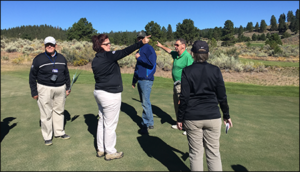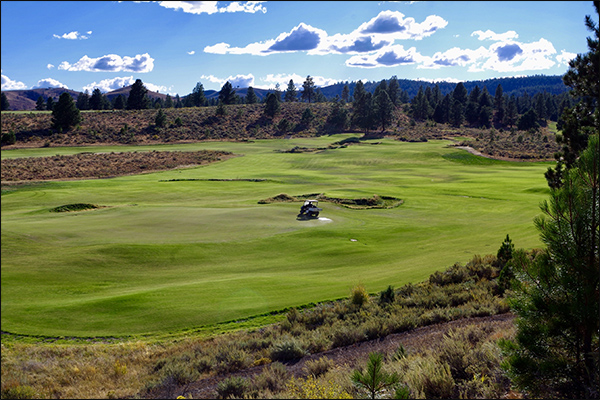The subtleties of rating a course are magnified when rating a reversible course, as at the soon-to-open Silvies Valley Ranch.
by Gretchen Yoder
Almost every sport has consistent guidelines for the field, court or rink. Basketball courts in the NBA are 94 by 50 feet. A football field is 100 yards long and 53 and one-third yards wide. Tennis courts are 78 by 27 feet. A ping-pong table is nine by five feet.
Every golf course, however, is different and unique.

Along with the standard nine and 18-hole courses, the USGA Course Rating System also has to account for non-traditional courses. For instance, there is the 6-hole Kinzua Hills GC in Fossil, Ore. And non-traditional courses are becoming a more practical option these days. Water is in short supply. Land use might be heavily regulated.
One way to economize land while still having access to two courses is to build a “reversible” course, such as the new Tom Doak-designed The Loop at Forest Dunes in Roscommon, Mich.
Last summer, the Oregon Golf Association’s Course Rating team visited a new facility in Eastern Oregon. Silvies Valley Ranch, a 140,000-acre working ranch located about three hours east of Bend and set to open in July 2017, has two 18-hole regulation golf courses – the Hankins and Craddock courses – which partially overlay each other. There are 27 greens shared between the two courses.
Oregon native Dan Hixson designed this amazing golf complex to utilize and enhance the natural topography and beauty of the landscape. “Even while I was building Wine Valley (in Walla Walla, Wash.) I was thinking about a reversible course,” Hixson said. “I’d even thought of designing Wine Valley as reversible. When we first started talking about the routing of Silvies, I brought up the notion of making the middle six holes as reversible, and the family said, ‘Let’s just do the whole thing as reversible,’ and I said let’s go.”
The distance alone created some issues. With the laser equipment now available, that usually takes three or four people about four hours to measure one course. Those measurements then need to be processed and calculated. Paperwork for the rating is then put together and printed. The rating phase alone takes one day on the course.
I worked with the Golf Association of Michigan (GAM) Course Rating team responsible for rating The Loop in Michigan to try and more efficiently measure and rate the special circumstances at these two courses.
The OGA and GAM both ended up taking an extra-large group to help measure so that we could finish in one day. The process included several people placing reflective measuring targets on each tee box while using spray paint to mark where the permanent marker should be placed. Other team members held targets in the fairways and at appropriate doglegs. One person helped me with taking notes while I measured. We also had the people on the green mark the front and back of the green as well as take all measurements important to green calculations (green size, bunkers, OB, etc.). We wrote on color-coordinated paper that matched the targets to indicate which course was being measured and avoid any confusion.
While GAM measured both Loop courses in one day (coming back at a later date to take care of the Course Rating procedure), we didn’t have that luxury because of the remoteness of Silvies Valley, so set out to stay at Silvies for three days to get everything done in one trip.
We measured both courses in one day. The team went out for the golfing assessment of one of the courses while I sat in the maintenance building and worked out the yardages for the Hankins course and got the forms ready and printed for rating the next day. On day two, we rated Hankins and then played Craddock. That night I ran the yardage and got paperwork ready for Craddock, then rated it the next day, after which we hitched up our wagons and moseyed on home.
Along with the two courses overlaying each other on several holes, there were a few additional challenges. Course Rating bases obstacle factors on the measured distance from the center of the fairway to where trouble lies. This is difficult to measure when fairways are incredibly wide and the extreme rough (sagebrush, rocks and general unpleasantness) was sometimes over 150 yards away. Topography, stance and lie of the ball, is the main challenge of both courses.

The added factor of elevation of both courses being between 4,650 and 4,850 feet, meant for considerable up- or downhill holes, affecting many shot lengths. It is hard to believe that two courses that intertwine, sharing several fairways and greens, could be as different as they are.
The Process of Course Rating
Correct and accurate yardage is imperative to Course Rating. Once yardage is established, a team of Course Raters assess the golf course, one hole at a time, taking into account the landing zones, where the ball lands and rolls, for each of four players: the Scratch and Bogey player, and Male and Female.
All obstacles are then measured from the center of each landing zone. There is then a numerical evaluation of all obstacles. Generally, the nearer the obstacles are to the center of the landing zone, the higher the rating values. Here is a list the Course Raters need to take into consideration.
- Topography: The impact of terrain on stance, lie and the player’s ability to hit the next shot.
- Fairway: The evaluation of the difficulty of landing and keeping a ball in the fairway from tee to green.
- Green Target: The probability of hitting and holding the green from a fairway landing zone or tee. The length of the shot as well as the size of the green determines these values.
- Recovery and Rough: If a player misses the green or fairway landing zone, how difficult will it be to recover?
- Bunkers: The measurement of the effect bunkers have on play based on their proximity to target areas and difficulty of recovery.
- Out of Bounds/Extreme Rough: How near or far is OB from the center of the landing zone? If there is tall grass, how likely will the player be able to find and then play their ball?
- Water Hazards: Look at how much the water will come into play based upon its proximity to landing zone or green. Is the water beside the fairway, a five-yard stream or a 100-yard pond that a player needs to carry?
- Trees: Measure of how close trees are to play and how difficult it is for the player to recover from the trees.
- Green Surface: A measurement of the actual difficulty of putting on a green. Stimpmeter speed, slope and contouring are all factors.
- Psychological: The system automatically calculates this factor based on the cumulative effect of multiple obstacles and also gives an extra “bump” for the stresses of the first and last hole.
(For complete information, visit the Handicapping and Course Rating pages of the websites of your State or Regional Golf Association – oga.org, theiga.org, thewsga.org, and britishcolumbiagolf.org.)
Gretchen Yoder is the manager of handicapping and course rating for the Oregon Golf Association and also serves on the USGA Course Rating Committee.

